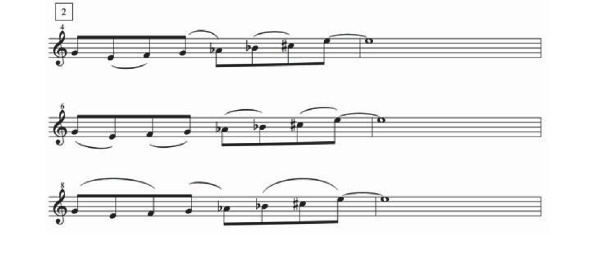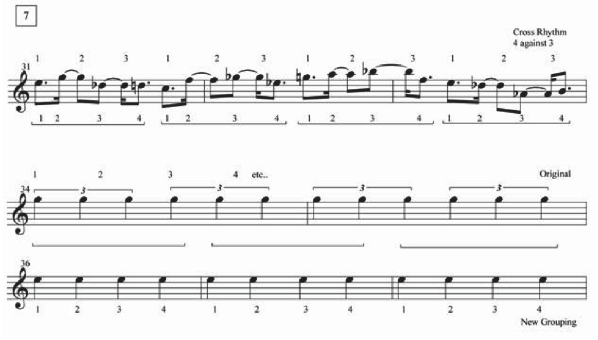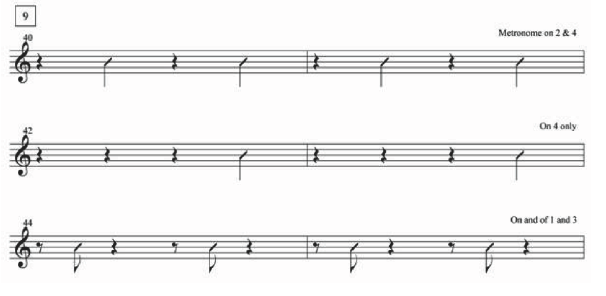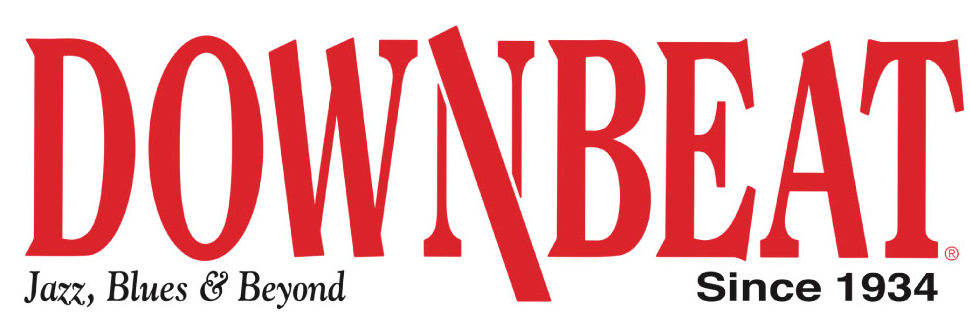by DAVID LIEBMAN
What is Jazz Rythym
When one listens to music what are the key elements that a listener responds to aside from the obvious factors of volume and intensity? Beyond the actual notes played (melody and possibly harmony depending upon the music) there are two aspects that immediately affect any listener. This is especially true in an improvised art such as jazz where the composition is secondary to the performance itself. It is also true that these two elements are central to discerning the style and musical personality of the artist. In jazz, if we were to give five saxophonists the same notes to play in the same tempo and context, why would we immediately know that player one was Sonny Rollins while the other was for example Wayne Shorter?
The first impression that affects the listener is the sound emanating from the instrument. The tone that is heard is an extension of that artist’s voice and on a deeper level, their persona. This is why instrumentalists in any serious music spend so much time learning to control tone quality and sound. In the final result it is the voice of the performer through an instrument that is being heard.
In jazz after tone, it is what I call “time feel” that most expresses an artist’s unique conception. The manner in which the player rhythmically phrases is to an even larger degree more revealing than the actual melodic and harmonic content. It conveys a truly physical impression to the listener which is difficult to describe in words.
There are improvised traditions outside of jazz which have existed for centuries, one of the most prominent being Indian classical music. The idea of taking a melody and spontaneously creating variations within a certain rhythmical context is hardly new. One factor that separates jazz from other improvised idioms would seem to be the harmonic implications, stemming from the Western classical tradition. But as we know there are styles of jazz where harmony is either not employed or minimized to such a degree as to not be relevant. So it seems that what really distinguishes improvised traditions worldwide is the specific rhythmical context. And jazz certainly has a unique character in that respect.
In the first one hundred pages of Gunther Schuller’s seminal work, “Early Jazz”, the author gives a fantastic account of how certain elements of jazz evolved and in particular tracing the development of that central aspect of jazz, “swing”. One important point Schuller makes is that in jazz, the second and fourth beat of a 4/4 measure achieves equality (some would say even primacy) with the other beats of the bar. This is in marked contrast to a large majority of familiar musical traditions, especially in the Western cultures (where for the sake of discussion 4/4 is standard) in which the first beat assumes priority over the others. He points out that this marking off of the first downbeat is for obvious reasons when the music serves the purpose of dance or marching. In any case
every jazz musician knows that “two” and ”four” are the swinging beats and in fact it is the four that really swings, while the upbeat of four swings even more!!
What is essential for every jazz player to realize in their playing is how pitches are linked together in a line with some sense of a rhythmical momentum. This momentum has ramifications about it, whether it is cast in a forward, aggressive manner or a relaxed, laid back sense. One way of describing this feeling is to use the word “groove” in describing rhythmic momentum. Of course pop music in the last part of the 20th century also placed great emphasis on a groove, but that is a direct outgrowth of dance music and the purpose that any dance music serves, whether it be from the fifteenth or twenty-first century, be it a mazurka or an African tribal ceremonial dance. A musician’s groove in the jazz rhythmical language is most evident when the eighth note division is maintained.
Eighth notes are the main denomination of jazz time, much like the penny is to the American dollar. Although one may not play only eighth notes, they still serve as the underpinning of jazz time, similar to what the clave beat is in Afro Cuban music, meaning if not necessarily stated it is implied. A note here on terminology:what are called eighth notes in jazz may also be conceptualized as triplets with a space between the first and third part of the three part division, or it can be seen as a dotted eighth followed by a sixteenth note. For the purposes here the distinctions are not important. In short, when a jazz musician sees eighth notes written on a page, (s)he immediately plays the rhythm either like a dotted eighth followed by a sixteenth or the above described triplet.
In order to master the subtleties of playing convincing and swinging eighth notes it is necessary to understand various aspects that play a role in their execution. It is important to remember that though there are technical variables which are peculiar to each instrument in the actual playing of eighth notes, the effect is still the same. So though a pianist must for example figure out the proper finger movement to articulate eighths compared to a saxophonist’s use of the tongue striking a reed or the string player’s plucking, the goal is still the same which is well placed eighth notes. It’s understood that from the standpoint of being an instrumentalist, each musician must discover and practice the intricacies of execution which are idiosyncratic to their instrument.
To return to the discussion of what I term “time feel” I am not discussing aspects of syncopation, rhythmical augmentation and diminution, hemiola, etc., which describe actual rhythmical constructs themselves. No matter what rhythms are employed, be they eighths, sixteenths or whatever, it is the way these rhythms are played which determine the ambiance or feel of the music. I would venture to say that the emotional aspect of the music is greatly affected by how rhythm is played, maybe more so than what the rhythms themselves are made up of. A plausible definition of a good jazz rhythmic feel should involve words like “accurate” (meaning as close as possible to the original and ongoing pulse), “even” (connotating a smooth rather than choppy or awkward flow), “variable” (meaning not entirely predictable using a variety of rhythms) and of course our original word “swinging”.
What is swinging or not is to some extent a matter of taste and acclimation. That which swings to the novice versus the educated listener may be entirely different, but even among so-called experts, the feeling of swing is so personal and subjective as to seem to be beyond discussion (though there is indeed much intense discussion about what does or does not swing). However, I think we could generalize that a feeling of swing has a drive or momentum in balance with a feeling of relaxation and effortlessness. There is a “lilt” or bounce to the music that is beyond words. It is probably easier to point out what doesn’t swing than what does!!
Note some words of caution when attempting to describe rhythm in words. Unlike harmony and melody which can be clearly seen on the page making it available to be dissected and analyzed in very specific terms, describing a rhythmic feel, no matter whether it be jazz or Brazilian or whatever is from the start very difficult. Though we can describe rhythms themselves with technical terms, the effect or what I call time feel is basically beyond words. However we can describe the elements which determine this feel.
Phrasing
This expression is very commonly used as a general way to describe how rhythms are played. But in my opinion it is too general a word. If you ask someone what comprises a good rhythmic feel and they say “phrasing”, they haven’t really said anything. It’s like asking what do you eat for dinner and the reply is food!! But we can divide phrasing into its specifics.
1 – Articulation
Put simply this means the way a note is attacked, either at its onset where it is most obvious or more subtly the way notes are connected together in an ongoing line. The terms “staccato” and “legato” are most commonly used to describe two extremes of attack from hard to soft. But besides other musical terms such as tenuto, slur, accent, etc., it is nearly impossible to describe the grey area between the extremes of staccato and legato in words. In jazz, it is very much this middle area of articulation which is crucial to the feel. Another way to conceptualize articulation is as degrees of intensity in the attack of a note from light to hard, aggressive to gentle and so on. Another consideration is that certain styles of jazz might invoke one form of articulation as more favorable and therefore prevalent for that particular idiom. For example, one aspect of Charlie Parker’s innovations in the 1940s was his more legato articulation in combination with a constantly changing continuum between a relaxed and aggressive beat as compared to the earlier swing or dixieland players. John Coltrane’s articulation was more legato than the beboppers and so on. As a generalization we could say that the vast majority of articulations heard in jazz fall somewhere between staccato and legato with an incredibly vast palette of variety.
2 – Dynamics
This topic can be seen as a subdivision of articulation but it is important enough to be highlighted on its own. The use of an accent translates to a louder note which in turn obviously means what came before and after appears softer. The softest articulated note in jazz is termed interchangeably a ghost, swallowed or muffled tone. This up and down character of dynamics/accents is extremely important to the overall rhythmic feel and is an area where individuality can be clearly discerned. In jazz of course, both the articulations and accents are spontaneous and therefore open to much variability.
3 – “The Space Between”
This is a very subtle aspect of jazz phrasing which specifically involves the length of space between the downbeat and upbeat of two eighth notes. For the sake of explanation, recall that two eighth notes in jazz can be more easily described as a dotted eighth followed by a sixteenth or a triplet with the middle beat left out (EXAMPLE 1). With this in mind, the length of the dotted sixteenth or first two parts of the triplet or the first eighth note, depending upon how one conceptualizes it, can be varied mathematically and microscopically to reflect a whole palette of proportions between the two divisions of the beat. Some musicians have a long duration of the downbeat than others, for example the ride beat cymbal pattern of drummer Elvin Jones. On the other hand, the great Tony Williams had an almost opposite proportion in his ride beat, all depending upon tempo and other factors of course. Each artist brings his own way of feeling this division to the music. This variable has a large effect upon beat placement, discussed below.
4 – Nuance
This is by far the most individualized aspect of time feel for it encompasses all sorts of expressive devices, nuances and inflections. Totally dependent upon the characteristics of an instrument in combination with the personality and control of the player, it is through the use of nuance that the emotion of a line is felt, both rhythmically and melodically. This is the equivalent to how an actor uses his voice to express sadness or happiness inflecting the same words by tone and nuance. This is speech brought to music, pure and simple. Some common devices, again dependent upon the instrument are vibrato, smears, portamento, grace notes, bent tones, vocalizations, etc. Every great individualist has his own set of nuances which are completely personal and become a sort of trademark. If you think of for example just the way pianists like Herbie Hancock, Keith Jarrett and Chick Corea play grace notes, the variety and uniqueness is astounding.
4 – Nuance
This is by far the most individualized aspect of time feel for it encompasses all sorts of expressive devices, nuances and inflections. Totally dependent upon the characteristics of an instrument in combination with the personality and control of the player, it is through the use of nuance that the emotion of a line is felt, both rhythmically and melodically. This is the equivalent to how an actor uses his voice to express sadness or happiness inflecting the same words by tone and nuance. This is speech brought to music, pure and simple. Some common devices, again dependent upon the instrument are vibrato, smears, portamento, grace notes, bent tones, vocalizations, etc. Every great individualist has his own set of nuances which are completely personal and become a sort of trademark. If you think of for example just the way pianists like Herbie Hancock, Keith Jarrett and Chick Corea play grace notes, the variety and uniqueness is astounding.
ADVANCED RHYTHMICAL CONCEPTS
Against the Time
Although eighth notes remain the main backbone of jazz time, the greatest improvisers demonstrate a rhythmic flexibility that can be mind boggling using inventive ways of playing permutations, subdivisions and metric modulations that can go so far as to suggest another tempo against the ongoing pulse. I call this “against the time” meaning that a polyrhythm is created by a musician playing a subdivision with such clarity and consistency that another pulse has been created. A most basic against the time rhythm is three against two (quarter note triplets) and then even further divisions of that. But there are multiple choices available and one can listen to the incredibly sophisticated rhythmic cycles of South Indian music for these and other advanced techniques. Once again Sonny Rollins played this way quite a bit during the first half of the 1960s on recordings titled “Alfie”,” the Standard Sonny Rollins”, “Our Man in Jazz” and more. Wayne Shorter with Miles Davis in the mid 1960s demonstrated this quite a bit while in that same band Herbie Hancock and Tony Williams played fantastic sub divided rhythmic cycles. Saxophonist Steve Coleman and bassist Dave Holland have delved deeply into this area in recent times.
Over the Time
A more abstract concept very much demonstrated by Eric Dolphy, Ornette Coleman and John Coltrane at various periods is what I term over the time. This means that for small episodic passages the improviser creates a sense of being out of time without an obvious reference point. Usually these are fast noted passages and wild sounding in texture, but the effect is of the improviser freeing himself from the ongoing pulse like a bird in flight, quickly returning with a vengeance to earth, or in other words completely swinging in time. The ability to do this gracefully is one of the highest forms of time playing in my opinion. To be free but to know where you are at the same time is magical. It is the equivalent of playing truly chromatically, meaning in another key but with an underlying reference to the home key center.
Achieving Rythmic Freedom
Practicing rhythmical concepts in a disciplined orderly fashion is difficult compared to harmony, instrumental technique, arranging, etc. Surely one can read rhythmical exercises and sing/play them, or initiate drummer type work which is beating rhythms and cycles with one hand against another and so on. But the reality is that for non-drummers, practicing the concepts I have described is quite ambiguous, so a certain amount of creativity and imagination is called for.
Listening
Because of its inherent ambiguity, after the basics of coordinating rhythmical movement in pulse, further development is more of a conceptual challenge rather than only technical. If a musician can learn to hear a certain way, noticing what I have described and more, there is an increased likelihood that these concepts will have a chance to register in the mind, body and ear. With repeated listening and repetition, coupled with a positive “I can” attitude, real musical change can occur. Therefore the first thing to do is to learn to listen not only to the main soloist or prominent activity going on, but concentrate upon the entire rhythmic flow occurring in the band. What are the relationships between the drummer’s ride beat pattern and the bassist’s quarter notes (assuming steady walking time); between the drummer’s left hand accents and off beats with the main chord player’s comping patterns and rhythmical “hits”; how are the musicians dealing with beat placement…is it constantly changing…is it the same…is it on top or bottom of the beat, etc? Noticing something by listening and observing can go a long way towards improving one’s actual playing.
Metronome
It goes without saying that at some stage of development, (the earlier the better), everyone must practice scales, arpeggios, lines, patterns and so on with the metronome executing the material accurately in time. For jazz, it is best to immediately get used to the metronome marking off the second and fourth beat of a 4/4 bar. After doing that reasonably well at tempos ranging from slow to very fast, I urge the student to use the metronome more creatively in different parts of the bar, for example only the fourth beat, or only the upbeat of three, or the upbeat of one, etc. The idea is that a musician can get very loose and confident in relations to feeling all four beats without being tied down to one, two, three, four. Great drummers are not always going to be that obvious when they are playing at the height of their creative game. You wouldn’t want to ask Jack DeJonette to please make sure that he gives you the one of the bar every eight measures!! I remember the wonderful drummer Pete La Rocca, who was my very first mentor back in 1969 saying that for him every beat was a one. In other words there was no four/four.….it was just one, one, one, one, meaning accents could appear anywhere in the bar. In any case every musician should get friendly with the metronome. Once this is accomplished it can be put away forever at least in this regimented and rigid aspect.
Beat Placement
After a certain degree of accuracy of pulse is established I urge the student to purposely try to play ahead and behind the beat. At first just use simple scales, licks or forms such as the blues that are automatically under the fingers so you can concentrate on the task at hand, which is feeling the “area” of the beat in order to get that part of the body which is responsible executing what one feels and hears. Using a playalong record can help since whatever the rhythm section feels like, at the least it remains in the same place time after time, so you can use this as a sort of barometer to play with in order to habitualize the sensation. This is really more of a physical exercise than just musical. One must feel the beat as a rubber band—expanding and contracting at will, but never so far as to drag or rush the beat!!
Transcription
I have written a great deal over the years on this all important method of learning the thought patterns as they pertain to notes and harmonies (the Complete Guide to Transcription video available through Caris Music Services). But even more so in the area of nuance and time feel, there is no better method for understanding what is involved than to be able to imitate a model who does it expertly. Through transcribing and exact replication of every aspect of the performance, it is possible to analyze the possibilities demonstrated on the recording, copy the methods and eventually use this accumulated material to enlarge and develop one’s own palette of expressive devices.
Be a Drummer
Any serious musician knows that understanding and at least having a minimal amount of execution concerning the piano is mandatory for musical excellence. In the area of rhythmic feel it is the same for learning drums. All musicians should feel what it is like to account for every beat over the course of an entire performance. The physical aspect of “riding” the cymbal and keeping the pulse is beyond description. But even a casual familiarity with the drums will be revelatory. And anyway, who doesn’t like playing the drums or hanging out with drummers? They are always the loosest of musicians with a sense of tradition which rivals pianists. After all, drummers and drums are universal since the beginning of time. Even if it means just getting a pencil and playing on the table with records, this is a start. Furthermore, I urge everyone to work out with a real drummer in a duo setting. Try to make playing with a drummer a weekly activity. The two musicians should be specific as to what they want to accomplish. For example, today they may work on one of them playing over the time with the other being very accurate stating the form of the tune. Then listen back and try to understand anything that happened which was unclear. That is how we learn about each other’s instruments and musical concerns in order to enlarge our ability to communicate with other instrumentalists in a group.
Other Rythymically Based Musics
It goes without saying that any serious musician would be interested in other musical traditions which are heavily rhythmic. Some suggestions are the aforementioned Indian classical music, Afro Cuban, African and the Balkan traditions. The concept of grafting an idea from a different source to one’s own home idiom is both practical and enlightening. In other words, hearing something from another culture and imagining how it could be transformed to jazz is one of the most rewarding and enjoyable processes for encouraging and developing an individual style.
Attitude
Rhythmical confidence comes with time and experience, but it must be sought after to develop. If a musician is only satisfied with merely playing a never ending stream of eighth notes, excellent as far as the harmonic and melodic choices may be, then further development in the rhythmical sense will be difficult. What is “natural” meaning intuitive and easily grasped is a great place to start, but to excel one must go beyond. A budding artist should desire to expand their horizons so that the possibility of finding an individual voice can occur. That is the challenge of learning an art form…the quest for something new to enlarge one’s creative palette. Jazz is in the final analysis rhythmic music and it is the responsibility of the serious artist to do research into this mysterious and powerful universal force.












